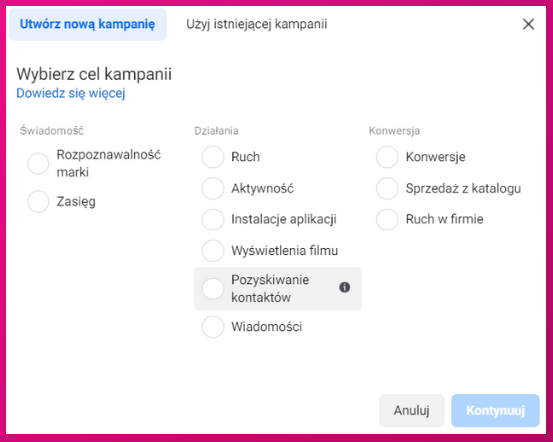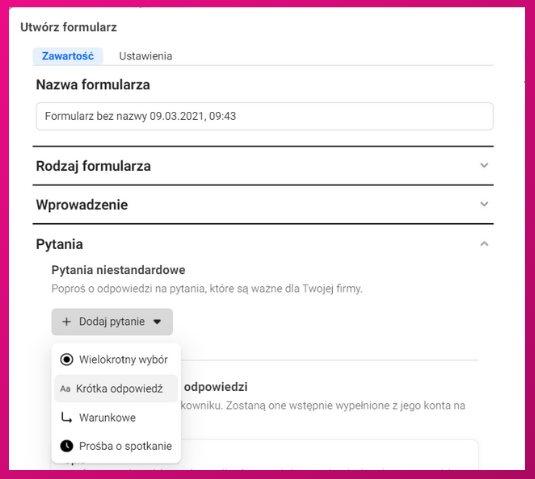Facebook ad campaigns with the objective “Get leads” are a great way to get leads that you can convert into loyal customers. However, not all leads you get may be valuable. So how can you protect yourself from “unwanted leads”?
Before we move on to what such a campaign should look like, let’s take a few steps back and answer the following questions:
- Have we already run paid campaigns? For how long?
- Who do we want to target with the campaign (new recipients or a remarketing campaign)?
- And the automatically arising question – at what stage of the funnel do we want to start such a campaign?
Depending on the answers to the three issues above, our actions will vary.
If we are a new brand that has never advertised or has only done so organically, it will be difficult for us to acquire valuable leads in such a campaign. The recipients to whom we will direct it do not know us, they have no idea about the price range of the services we offer. So there is a greater probability that the leads obtained will be vague. The recipients can fill out a form, we will then call them/send them an email with an offer, and they will make big eyes because it will turn out that "eee... I didn't know that these trainings/platforms/insert whatever you want here cost so much."

However, when we regularly create campaigns, we have already made ourselves known to new recipients, because, for example, we have directed reach campaigns to them, on activity towards posts, on traffic to our articles or showing videos with training samples. If we prepare the form well, refer to the target group in the creation and content, then there is a greater probability that the acquired contact will be more "warmed up", will know who is calling and why. He will simply be a customer who only needs to be gently led by the hand to decide on our product/service.
CAMPAIGN WITH THE GOAL OF "GAINING CONTACTS" ON FACEBOOK
What to pay attention to when creating an advertisement and form?
WHAT COPY TO PREPARE FOR A LEAD CAMPAIGN
First, let's prepare a few copy options that will directly address our target group. The content of the ad post can be very long or short. At KomuKoncept, we use several content options in one ad so that Facebook chooses the best one.
How can you refer to our group in your content?
- The simplest rule – name her. "Teacher! Teacher! Teachers!", "Parent", "Manager", "To all real estate agents".
- Ask a question, which will refer to the pain/need of the group, e.g.: "Do you feel that it's time to develop your skills?", "No hashtags, bad description in the BIO on Instagram?", "Have you recently had another argument?". These are questions that will easily filter out those who don't argue, those who don't care about Instagram, or those who don't need training at the moment.
- A good way is to use short but illustrative sentences that illustrate the main problem, statistics. For example, 73% companies participating in this training increased their revenue by x%” etc.
WHAT CREATION TO PREPARE FOR A LEAD CAMPAIGN
Secondly, let's prepare the most important thing in every advertising goal on Facebook, which is CREATION. Yes, this is the most important moment of "setting up ads". In creation, similarly to copy, we must address the problem/need of our recipients. So let's communicate:
- name of the target group (same as in copy),
- prices and dates (if any and if you can provide them),
- benefits,
- content, e.g. books or training.
What is the function of the creative? The most important thing for us is that it 'screens out' people who are not interested. This is an ideal solution for those who do not want to limit their audience too much. A clear and simple message "who am I talking to?" will hit the nail on the head.
Benefits and content are also important. Let's provide a list of training topics, a table of contents for a book or e-book in the creation. Let's present ourselves as specialists - let's record a video in which we explain how what we offer will help customers.
By preparing various creations, we give Facebook the opportunity to test them on our audience. After a period of testing, the algorithm will show us the best creation and copy.
HOW TO PREPARE A FORM IN A LEAD ADS CAMPAIGN
Finally, let's move on to creating the form.
Let's remember that Facebook automatically fills in basic fields, such as: name and surname, email, phone number, to make it as easy as possible for the recipient to use the form. We scroll through the feed quickly, we absorb content superficially, so Facebook has met the recipients' needs here. However, this is not a good solution if we want the leads that flow in to be valuable. Such a user will fill out the form in 5 seconds, they may not even look at the fanpages whose ad they have just reacted to. That is why we are in it to expand this module.
HOW TO EXPAND YOUR CONTACT FORM TO GET QUALITY LEADS

There is no single, correct answer to this. However, there are questions we can ask that will help us filter out another, 'unwanted' group of recipients.
For B2B campaigns, we suggest adding questions that require some effort from the recipient, e.g.:
- regarding the size of the company,
- about the target group,
- to choose a training package, including prices,
- a description of the product/service,
- to describe the single biggest problem he is struggling with,
- to name 2-3 competitors of the company.
For B2C campaigns, we suggest adding questions:
- regarding the topic of the product/service (if we are selling an e-book about health, let’s ask what this person has the biggest health problem with),
- regarding demographic data (if the recipients are parents, ask about the number of children).
Of course, these are just a few examples. The principle of these questions is one - we want the user to make a little effort and fill out an extended form.
SUMMARY
In conclusion, I want to make you aware of exclusions in Facebook campaigns. We can exclude not only at the ad set stage. First of all, what our recipient sees has an inclusive or exclusive character. And first they see the visual material, then they look at the content in the advertising post. Let's use this knowledge to easily create a message in these places.
Good luck with your campaign creation! And if you have any questions, drop me a line ola@komukoncept.pl and schedule a consultation.
- Written by: Ola Dzwierzyńska
- Posted on: 9 Mar 2021
- Tags: advertising manager, Facebook advertising

